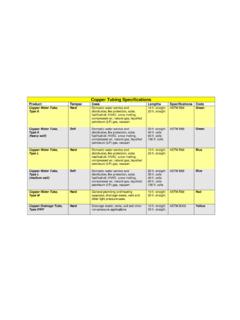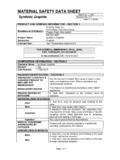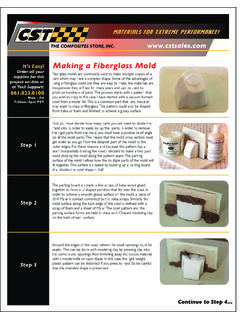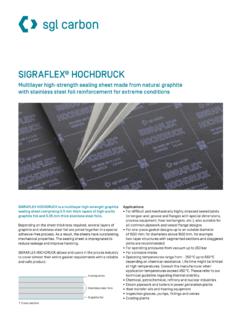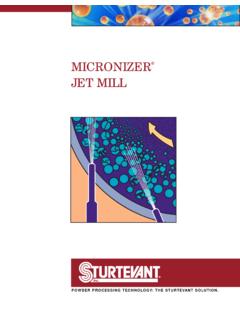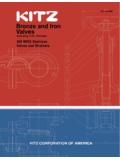Transcription of STRITT & STRITT &&& PRIEBE INC.PRIEBE INC.
1 S T R I T T S T R I T T S T R I T T S T R I T T &&&& P R I E B E I N C .P R I E B E I N C .P R I E B E I N C .P R I E B E I N C . 37 Clyde A ve ~ Buff alo , New York 14215 ~ itt an dPrieb e .com fax CONVENTIONAL VALVE SEAT AND seal MATERIALS This information is intended as a guide. Each application should be carefully checked & verified prior to installation. Buna-N (HYCAR or Nitrile) is a general purpose polymer which has good resistance to oil, water, solvents and hydraulic fluids. Least expensive elastomer. Good chemical resistance Good compression, abrasion resistance, and tensile strength.
2 Performs extremely well in process areas where paraffin base materials, fatty acids, oils, alcohols or glycerins are present, since it is totally unaffected. Should not be used around high polar solvents (acetones, ketones), chlorinated hydrocarbons, ozone, or nitro hydrocarbons. Temperature range: -40 F to 225 F Black in color and should not be used where discoloration cannot be tolerated. EPDM is a terpolymer elastomer made from ethylene-propylene diene monomer. EPDM has good abrasion and tear resistance and offers excellent chemical resistance to a variety of acids and alkalis. Good resistance to mild acids, dilute alkalis, silicone oils and greases, ketones and alcohol Not recommended for applications involving petroleum oils, di-ester base lubricants, strong acids, or strong alkalis EPDM should not be used on compressed air lines Exceptionally good weather aging and ozone resistance Temperature rating is from -40 F to +225 F (250 F intermittent service) Flexible Graphite, also known as Grafoil, is made from mineral (flake) Graphite.
3 Since it is flexible, it is referred to as Flexible Graphite to distinguish it from other forms of Graphite materials. Flexible Graphite is a naturally solid lubricant. Chemically resistant to attack from nearly all organic and inorganic fluids with the exception of highly oxidizing chemicals and concentrated, highly oxidizing mineral acids. Excellent electrical conductor. Great for body and stem sealing on Fire Safe Ball Valves Temperature range: -400 F to +750 F Neoprene was the world's first synthetic elastomer. Neoprene features high resiliency with low compression set flame resistance and animal and vegetable oil resistance.
4 It is principally recommended for use in pulp and paper applications. Attacked by strong oxidizing acids, most chlorinated solvents, esters, ketones, aromatic hydrocarbons and hydraulic fluids Not generally affected by moderate chemicals, fat, greases and many oils and solvents Temperature rating is from -20 F to +180 F. Hypalon has very good resistance to oxidation, ozone and good flame resistance. It is similar to neoprene except with improved acid resistance where it will resist such oxidizing acids as nitric, hydrofluoric and sulfuric acid. Excellent abrasion resistance Oil and solvent resistance is somewhat between that of neoprene and nitriles.
5 Salts have little if any effect Not recommended for exposure to concentrated oxidizing acids, esters, ketones, chlorinated, aromatic and nitro hydrocarbons. Not to be used in steam service. Temperature rating is from 0 F to +220 F PEEK (Polyetheretherketone) is a high performance organic polymer thermoplastic. It is one of the very few plastics compatible with ultra-high vacuum applications. PEEK is considered an advanced bio-material for use in medical implants. Excellent choice for high pressure and high temperature service Highly resistant to thermal degradation as well as attack by both organic and aqueous environments Unaffected by continuous exposure to hot water or steam Excellent resistance to radiation Excellent abrasion and corrosion resistance Unsuitable for use on Halogens and strong Bronsted and Lewis acids (such as concentrated Sulfuric Acid) as well as some halogenated compounds and aromatic hydrocarbons at high temperatures Service temperature range of -70 F to 600 F and steam service up to 500 F SILICONE.
6 Very good seat material, very elastic self-lubricating - provides a tight easy seal , reducing torque needed to close the valves. Sensitive to certain chemicals: do not use with solvents, petroleum products, etc. Temperature range: -85 F to 450 F TFE or PTFE (Teflon ) (Polytetrafluoroethylene) is a Fluorocarbon based polymer. This seating material has excellent chemical and temperature resistance and a low coefficient of friction. It also has excellent thermal and electrical insulation properties. It is the most commonly used seat material for food application. Not recommended for liquid alkalis and fluorine Highly Inert S T R I T T S T R I T T S T R I T T S T R I T T &&&& P R I E B E I N C.
7 P R I E B E I N C .P R I E B E I N C .P R I E B E I N C . 37 Clyde A ve ~ Buff alo , New York 14215 ~ itt an dPrieb e .com fax Limited toughness; therefore not always first choice for high cycles Very soft, can be forgiving of particle contamination Good low temperature / Cryogenic material Temperature range -50 F to 450 F. RTFE (Reinforced TFE) is compounded with a specific percentage (Generally 15%) of fiber glass filler to provide improved strength, stability and resistance to abrasive wear, cold flow, and permeation in molded seats over conventional unfilled PTFE. The reinforcement permits application at higher pressure and temperature than unfilled TFE.
8 Not recommended for applications that attack glass, such as hydrofluoric acid and hot strong caustics. Industry workhorse, generally good for most services Not recommended for steam, concentrated caustics, or high cycles at elevated temperatures Temperature range of -50 F to 450 F. Carbon Filled TFE is an excellent seat material for steam applications as well as high efficiency oil-based thermal fluids. Fillers, including graphite, enable this seat material to have a better cycle life than other filled or reinforced TFE seats. Chemical resistance is equal to other TFE seats Temperature range is -20 F to 500 F 50% Stainless Steel Filled PTFE has enhanced mechanical properties by the use of a 50% by weight (or 15% by volume) Stainless Steel Powder filling.
9 It combines the strength of metal with the lubricity of PTFE. Excellent abrasion resistance Excellent strength and stability under extreme loads and elevated temperatures Retains the low coefficient of friction of conventional PTFE Extremely versatile product Can be used on steam and thermal fluid applications Higher pressure and temperature ratings than RPTFE Temperature range: -20 F to 500 F PCTFE (Polychlorotrifluoroethylene) is a homo-polymer of Chlorotrifluoroethylene. In particular, it's cold flow characteristic is lower than all other fluoropolymers and it does not deform under load at room temperature.
10 High compressive strength and low deformation under load Extremely low gas permeability Essentially does not absorb moisture Generally only used for cryogenic applications such as oxygen, hydrogen and nitrogen Temperature range: -400 f to +400 F TFM 1600 is a modified PTFE that maintains the exceptional chemical and heat resistance properties of conventional PTFE, but has a significantly lower melt viscosity. It has a far denser polymer structure than conventional PTFE and exhibits better stress recovery. Exceptional chemical and heat resistance properties Reduced cold flow, Lower porosity and permeability, and lower void content Reduced deformation under load, Improved design flexibility.



